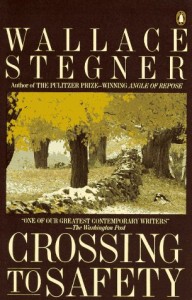 Having read his autobiographical novel Crossing To Safety, I feel I have a sense of who Wallace Stegner was, but recreating the writer from his fictions, even those most transparently personal, is always a perilous undertaking. It also happens to be a lot of fun. Like his author, Stegner’s protagonist Larry Morgan is a writer and teacher whose literary successes would not come until much later in his life. Having to support his wife Sally and their future firstborn, Larry takes a job as a professor in Madison, Wisconsin, where the competition for tenure, intensified by the bleak economic landscape of the Great Depression, leads them to meet and befriend another young married couple, Sidney and Charity Lang. Crossing To Safety is about the lifelong friendship that blossoms between these two couples and the ways this friendship shapes their lives.
Having read his autobiographical novel Crossing To Safety, I feel I have a sense of who Wallace Stegner was, but recreating the writer from his fictions, even those most transparently personal, is always a perilous undertaking. It also happens to be a lot of fun. Like his author, Stegner’s protagonist Larry Morgan is a writer and teacher whose literary successes would not come until much later in his life. Having to support his wife Sally and their future firstborn, Larry takes a job as a professor in Madison, Wisconsin, where the competition for tenure, intensified by the bleak economic landscape of the Great Depression, leads them to meet and befriend another young married couple, Sidney and Charity Lang. Crossing To Safety is about the lifelong friendship that blossoms between these two couples and the ways this friendship shapes their lives.
Published in 1987, six years before Stegner’s death, Crossing To Safety contains a lifetime’s worth of passions. The upper-class, educated and literate protagonists give Stegner ample excuse to draw on the full wealth of world literature, from Horace and Dante to Proust and T.S. Eliot. Larry, in particular, and in the way readers always do, is forever relating the events of his life to memorable lines of verse or passages from favorite works. Of these, the most salient is Cicero’s De Amicitia, a treatise on the nature of friendship that serves as a kind of blueprint for Stegner’s plot. What is friendship and how does it flourish? How do our friends shape us, and how do we, in turn, shape them? If this sounds terribly saccharine, Stegner handles his material with care, never allowing his thematic intentions to overshadow his characters. Sally, Sid and Charity are expertly drawn, neither sentimental nothings nor walking contradictions. We follow them through success and disappointment, sickness and health, and feel the same affinity for them that all literary darlings evoke. Even the headstrong Charity, who is on a number of occasions likened to a tyrant in her mastery of her husband, finishes the novel with our sympathy, if not our understanding.
The settings, too, of Vermont and Wisconsin, are skillfully evoked by Stegner, who devoted much of his life to environmentalism and the preservation of nature reserves. It is fitting that it is Robert Frost, so much America’s poet of nature, from whom Stegner takes his title; Frost’s “I Could Give All To Time” uses vivid imagery of the leveling of mountains and shifting of continents to impress upon the reader Time’s all-conquering power, before abruptly switching to a more personal mode:
I could give all to Time except – except
What I myself have held. But why declare
The things forbidden that while the Customs slept
I have crossed to Safety with? For I am There,
And what I would not part with I have kept.
What does it mean to withhold from Time? What can be withheld from time? The Safety Frost speaks of is a safety from Time, and while Frost declines even to hint at what these things may be that he has crossed over with, Stegner is adamant that friendship is a gift not worth parting from.
In an earlier post on Sontag’s Against Interpretation And Other Essays, I spoke about the tension, in literary circles, between irony and sincerity. This is unabashedly a sincere novel; it asks you to meet its characters head on, to sympathize with them rather than condescend to them, to maintain your allegiances until the bitter end. It is all the stronger for this.